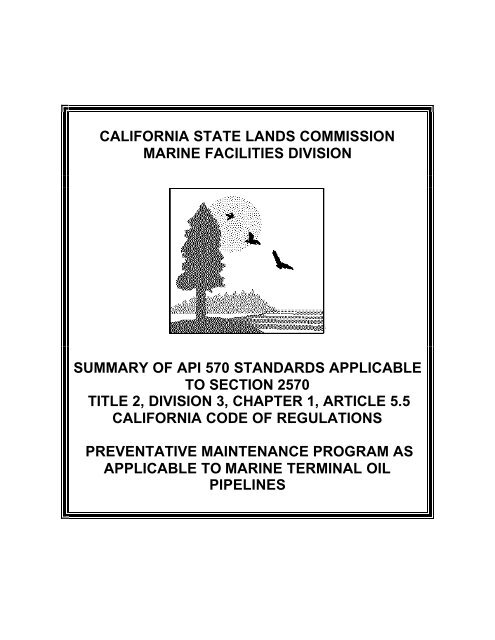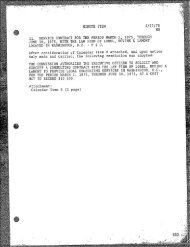API 570 Guide - State Lands Commission
API 570 Guide - State Lands Commission
API 570 Guide - State Lands Commission
You also want an ePaper? Increase the reach of your titles
YUMPU automatically turns print PDFs into web optimized ePapers that Google loves.
CALIFORNIA STATE LANDS COMMISSIONMARINE FACILITIES DIVISIONSUMMARY OF <strong>API</strong> <strong>570</strong> STANDARDS APPLICABLETO SECTION 2<strong>570</strong>TITLE 2, DIVISION 3, CHAPTER 1, ARTICLE 5.5CALIFORNIA CODE OF REGULATIONSPREVENTATIVE MAINTENANCE PROGRAM ASAPPLICABLE TO MARINE TERMINAL OILPIPELINES
<strong>API</strong> <strong>570</strong> STANDARDS AS APPLIED TO MARINE TERMINALOIL PIPELINESThe Preventive Maintenance Program referenced in 2 CCR Section 2<strong>570</strong> refersto applicable requirements and guidelines prescribed in <strong>API</strong> AmericanPetroleum Institute <strong>570</strong>, Piping Inspection Code (<strong>API</strong> <strong>570</strong>).The following is a summary of the applicable Sections of <strong>API</strong> <strong>570</strong> that pertainto Marine Oil Terminals regulated by the California <strong>State</strong> <strong>Lands</strong> <strong>Commission</strong>.The intent of this summary is to provide useful guidance for determininginspection and maintenance requirements under <strong>API</strong> <strong>570</strong> in compliance with2 CCR 2<strong>570</strong>. This summary provides basic information only. For further detail,please refer to the full text of both <strong>API</strong> <strong>570</strong> and 2 CCR 2<strong>570</strong>.Scope and Application, Section 1<strong>API</strong> <strong>570</strong> applies to in-service metallic piping systems used for the transport ofpetroleum products.Owner/Operator Responsibilities, Sections 4.31An owner/operator organization is responsible for developing, documenting,executing, and assessing piping inspection systems and inspectionprocedures that will meet the requirements of <strong>API</strong> <strong>570</strong>. These systems andprocedures will be contained in a quality assurance inspection manual orwritten procedures.<strong>API</strong> Qualified Inspector, Section 4.2, 4.3.4An <strong>API</strong>-authorized piping inspector (inspector) shall be responsible fordetermining that the requirements of <strong>API</strong> <strong>570</strong> on inspection, examination andtesting are met and shall be directly involved in the inspection activities. Othertrained and qualified individuals may assist the inspector in performing theinspection. Personnel performing nondestructive examinations need not bean inspector, but shall meet the requirements of examiner per <strong>API</strong> <strong>570</strong>,Section 3.12. All examination results must be evaluated and accepted by theinspector.
Inspector Certification, <strong>API</strong> <strong>570</strong> Appendix "A"An <strong>API</strong> <strong>570</strong> authorized piping inspector certificate is issued upon successfulcompletion of an <strong>API</strong> certification exam as well as meeting all educationaland experience requirements. The examination would certify inspectorswithin the scope of <strong>API</strong> <strong>570</strong>, Piping Inspection Code, Inspection, Repair,Alteration, and Rerating of In-Service Piping Systems. Certification shallremain valid for a period of three years at which time recertification is required.External Visual Inspection of Above Ground Pipelines, Sections 5.3, 5.4.3, 5.11,6.4Every five years at a minimum, an external visual inspection shall beperformed to determine the condition of the pipeline, supports and hardware,connections, deadlegs, expansion joints, insulation system integrity, andpainting and coating systems; and check for misalignment, vibration, leakage,and significant differences between pipeline drawings and actual installations.Pipe Wall Thickness Measurements, 5.5, 5.6, 6.5,7.1A thickness measurement survey shall be performed to determine theremaining pipe wall thickness at critical locations in the pipeline system andthroughout the pipeline. The survey shall include a representative sampling ofthickness measurement locations which includes data for all the variouscomponents and orientations (horizontal and vertical) within the piping system.Thickness measurement locations shall be carefully documented to allowrepetitive future measurements at the same location. (A thicknessmeasurement survey shall be performed at least triennially per 2 CCR 2<strong>570</strong>,Or at no more than one-half of the remaining life as determined from corrosionrates calculated per Section 7.1.1, whichever is less.Inspection Data Evaluation, Analysis, and Recording, Sections 7.1, 7.2,7.4, 7.6The following shall be calculated from thickness measurement data collected:minimum required thickness, maximum allowable working pressure basedupon the measured thickness, corrosion rate, and remaining life. Locallythinned areas may be further evaluated (e.g. ASME B31G Manual forDetermining the Remaining Strength of Corroded Pipelines or finite elementanalysis) to justify continued service. The owner/operator shall maintainappropriate permanent and progressive records of each piping systemcovered by <strong>API</strong> <strong>570</strong>. Records shall include: piping system service,classification, identification, inspection dates and inspector’ name(s) andaffiliation(s), all test data, inspection documentation and findings, repairs,alterations, rerating, and other information pertinent to pipeline integrity.
alterations, rerating, and other information pertinent to pipeline integrity.Inspection of Buried Pipelines, Sections 9.1.1, 9.1.5, 9.2.6, 9.3.1Every five years at a minimum, the route of buried pipelines shall be examinedby an <strong>API</strong> <strong>570</strong> qualified inspector at the surface and the following conditionsshall be noted: change in surface contour of the ground, soil discoloration, ornoticeable odor. Cathodically protected piping surveys shall be monitored onan annual basis to assure adequate protection levels; impressed current shallbe checked at intervals not to exceed two months (NACE RP 0169 and <strong>API</strong>RP 651). Significant corrosion detected by pigging or by other means shallrequire excavation and evaluation. Any coating removed for inspection shallbe re-applied.
















